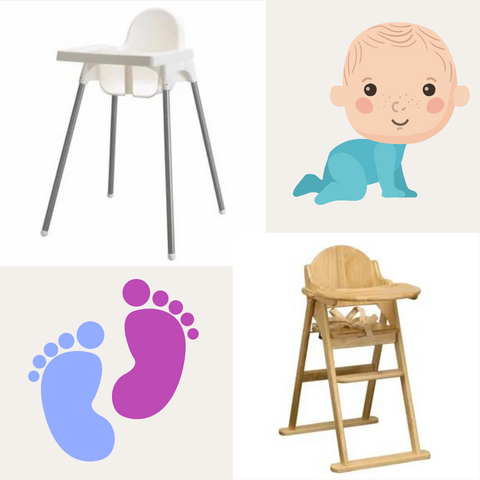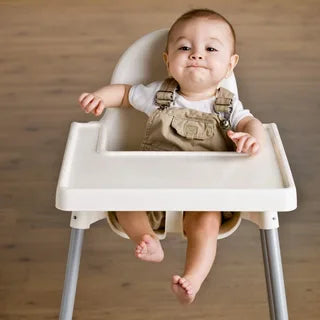
Every baby is different, but most parents may expect their child to be ready to sit in a high chair for about 4 to 6 months; in this article, we are going to discuss high chairs extensively. Having this new knowledge about high chairs will only take a few minutes.
Many parents look forward to this period since shifting into a chair allows you to free up some space in the kitchen and at the table. It also allows your infant to participate in some of the family's activities, which is beneficial for social development. High chairs are a convenient and safe option for feeding babies who have reached the age and developmental stage where they can sit with support. However, it is important to note that every baby develops at their own pace and may not be ready for a high chair at the same time as other babies their age; you can get your durable Modern high chair at Bellababy Store.
When determining whether a baby is ready for a high chair, it is important to consider their ability to sit with support. This means that the baby should be able to sit upright with minimal assistance and should be able to maintain this position for extended periods without slumping over. Additionally, the baby should have good head control and be able to hold their bottle or food.
High chairs are intended to offer a safe and secure location for newborns to sit while being fed, and they frequently include features like belts and trays to hold the baby firmly in place.

When Can Baby Sit in a High Chair?
When determining when a baby is ready to sit in a high chair, it is important to consider their developmental milestones. High chairs are designed for babies who have reached the age and stage where they can sit with support, typically around 6 months. However, every baby develops at their own pace, so paying attention to your baby's individual development is important.
One of the key milestones to look for is the ability to sit upright with minimal assistance. This means that the baby should be able to maintain an upright position without slumping over or needing to be propped up. Additionally, the baby should have good head control and be able to hold their bottle or food.
Another important factor is the baby's ability to sit for extended periods. High chairs are designed for feeding, which can take some time, so the baby must be able to sit in the chair for the duration of the meal without getting fussy or uncomfortable.
It's also important to note that high chairs come in different styles, and some may be more suitable for younger babies than others. Traditional high chairs often feature a tray that attaches to the chair and can be removed for easy cleaning. These high chairs usually have straps to keep the baby secure, but they may not be as adjustable as more modern high chairs.
On the other hand, modern high chairs are designed to be more versatile and can be used for longer periods. They may have adjustable seats and footrests and can often be converted into toddler chairs once the baby outgrows the high chair stage.
In conclusion, when determining if a baby is ready to sit in a high chair, it is important to consider their developmental milestones and ability to sit upright with minimal assistance, has good head control, and sit for extended periods. It's also important to consider the different styles of high chairs and choose one that best suits your needs and the baby's development stage.
When you are working and the nanny takes care of the baby, you can use Sense-U Baby Monitor to record the baby's growth.
Types of high chairs
We have two types of high chairs, which are:
- ✅ Traditional high chairs
- ✅ Modern high chairs.
✔ Traditional high chairs: basic design, often with removable trays and straps to keep baby secure. High chairs come in different styles, some of which are more suitable for younger babies than others. Traditional high chairs are the most common type and often feature a tray that attaches to the chair and can be removed for easy cleaning. These high chairs usually have straps to keep the baby secure, but they may not be as adjustable as more modern high chairs.
✔ Modern high chairs: Modern high chairs, on the other hand, are designed to be more versatile and can be used for longer periods. They may have adjustable seats and footrests and can often be converted into toddler chairs once the baby outgrows the high chair stage. Its more versatile, adjustable seats and footrests can be converted into a toddler chair.

♥Features to look for in a highchair
• Safety features: Look for a high chair with a secure and sturdy design, as well as features such as straps and trays that keep the baby securely in place.
• Adjustability: Consider a high chair with adjustable seat and footrest positions and a tray that can be adjusted for different feeding heights.
• Ease of cleaning: Look for high chairs with removable trays and easy-to-clean surfaces, as well as the ability to wipe down or machine wash the seat pad.
• Convenience: Features such as wheels and a folding design can make it easier to move and store the high chair when it's not in use.
• Durability: Consider a high chair made of durable materials and built to withstand the wear and tear of regular use.
• Versatility: Some high chairs can be converted into toddler chairs once the baby outgrows the high chair stage; look for these options that will serve the baby for a longer period.
Over to mom
It's important to consider a baby's developmental milestones and the different types and features of high chairs before introducing them to one. High chairs are a convenient and safe option for feeding babies who have reached the age and developmental stage where they can sit with support. It's important to consider the baby's ability to sit with support, good head control, and hold their bottle or food before introducing them to the high chair. Also, it's important to consider the different styles of high chairs and choose one that best suits your needs and the baby's development stage.










